
By Dr. Christopher Mah, Research Collaborator - Smithsonian Institution
March 24, 2017
Sea stars are among some of the most ecologically important of marine invertebrates. Some are predators while others are scavengers, but they aren’t known for their rapid movements. So what behavior/structural features have evolved to keep them from being devoured?
What feeds on sea stars? This is not well known for all sea stars, but in shallow-water habitats, sea stars often defend themselves against fish. Some starfish species have chemical based defenses such as slime (see below), others have bad tasting or toxic chemicals in their body wall, while others have physical deterrents such as spines or armor.
For a general account on sea star defenses, visit this page .
Sea stars (also called starfish) are members of the phylum Echinodermata. A Latin word which translates into "spiny skin." And indeed, MANY members of the group possess very sharp and well-developed spines, which are thought to be used primarily for defense.
Many of these sea stars are either scavengers or feed by lowering their stomachs onto the sea bottom and finding snails and clams to eat. As a result, these animals are out in the open and in the deep-sea, that makes them vulnerable to predators. However, many species simply have very big, sharp spines that make putting the animal into one's mouth a very costly and unpleasant lesson.
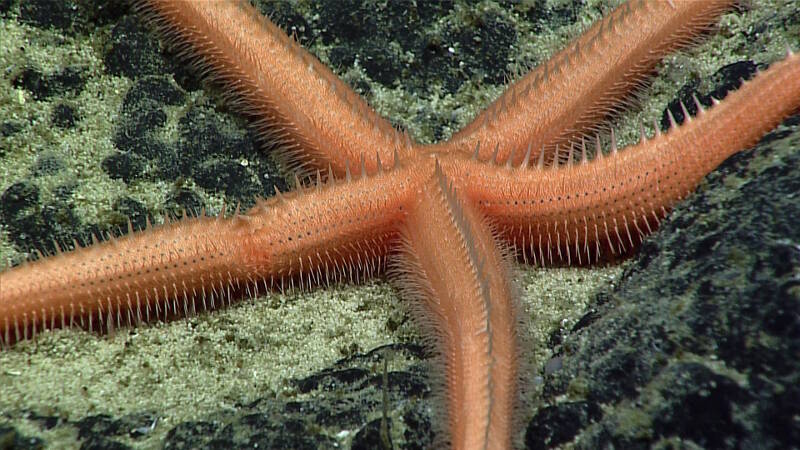
This Zoroaster sea star was imaged during the second dive at Titov Seamount of this expedition. Note the bristling series of spines present along the arm radius as well as along the sides of the arms. These aren't casual or fragile structures; I've worked with these starfish specimens on ships and in museums—the spines are quite sharp and can penetrate thin rubber gloves. Image courtesy of the NOAA Office of Ocean Exploration and Research, Discovering the Deep: Exploring Remote Pacific Marine Protected Areas. Download larger version (jpg, 1.6 MB).
The Benthopectinidae are known throughout the world, from deep-sea and Antarctic settings. Most members of this group are known for having a serial array of sharp spines around the margin. Spines are comparable to Zoroaster (above) in terms of sharpness and are a formidable group to encounter when studying sea stars.
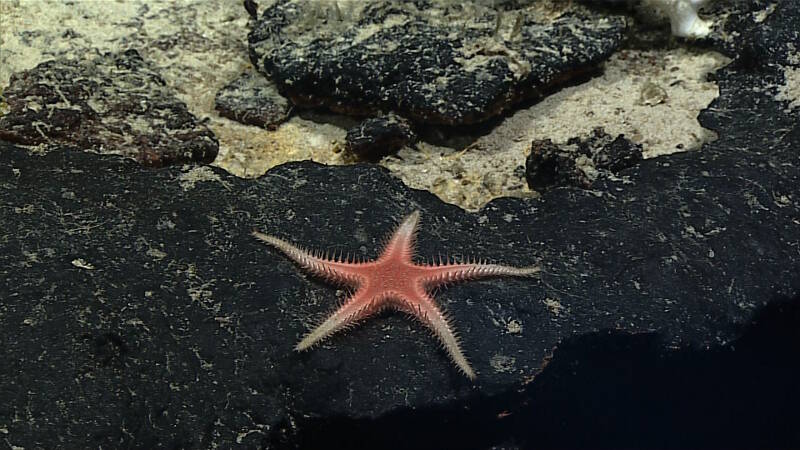
This Cheiraster (Benthopectinidae) sea star was imaged on Dive 04 of the expedition at an unnamed seamount in the Tokelau Seamount Chain. Image courtesy of the NOAA Office of Ocean Exploration and Research, Discovering the Deep: Exploring Remote Pacific Marine Protected Areas. Download larger version (jpg, 1.3 MB).
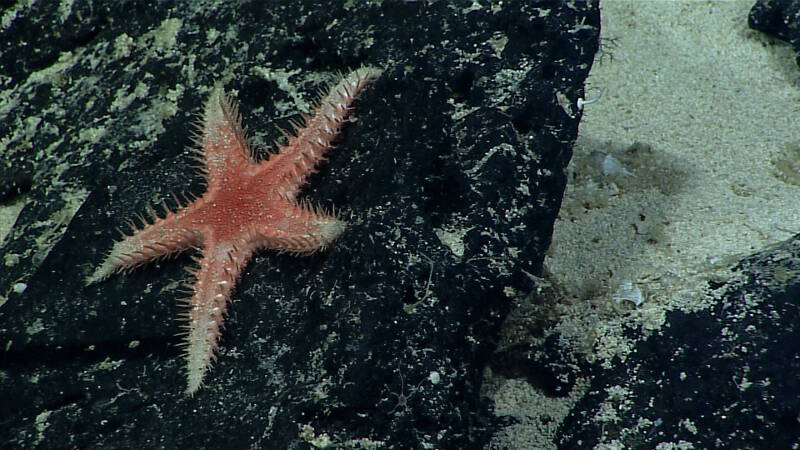
This benthopectinid sea star was also imaged during Dive 04 of the expedition at an unnamed seamount in the Tokelau Seamount Chain. Image courtesy of the NOAA Office of Ocean Exploration and Research, Discovering the Deep: Exploring Remote Pacific Marine Protected Areas. Download larger version (jpg, 1.5 MB).
Several sea stars in the family Goniasteridae are predators on deep-sea corals, including bamboo corals and other ecologically important species. Curiously many of them display very sharp, stout spines around the edge of their body or sometimes covering the entire surface. It is unclear precisely why they have these spines, but they may help to defend against other predators while the sea stars devouring coral.
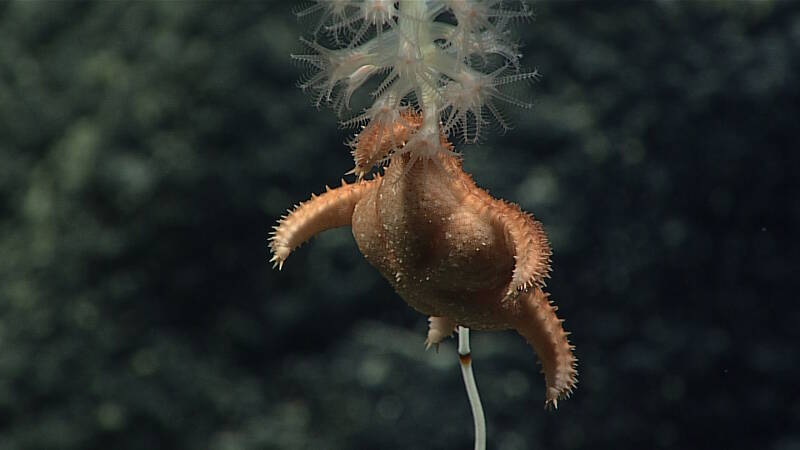
This coral predator Calliaster in the family Goniasteridae was imaged predating on a bamboo coral at Titov Seamount during the seventh dive of this expedition. Image courtesy of the NOAA Office of Ocean Exploration and Research, Discovering the Deep: Exploring Remote Pacific Marine Protected Areas. Download larger version (jpg, 760 KB).
Perhaps one of the most unusual of the sea stars we encounter in deep-sea habitats are those in the family Pterasteridae, specifically in the genus Hymenaster. These bizarre-looking sea stars have a very weakly developed skeleton which is almost gelatinous in texture. These animals are relatively large (about 10 centimeters in width) and have a highly unusual surface appearance.
But one of the most unusual aspects of these sea stars is their use of a specific defensive mechanism. When agitated, they can project streams of mucus at potential predators. While the deep-sea species are not as well known, shallow-water "slime stars" can repel potential predators, such as snails, crabs, and predatory sea stars. In the author's personal experience, these animals can produce a fair amount of mucus when threatened!
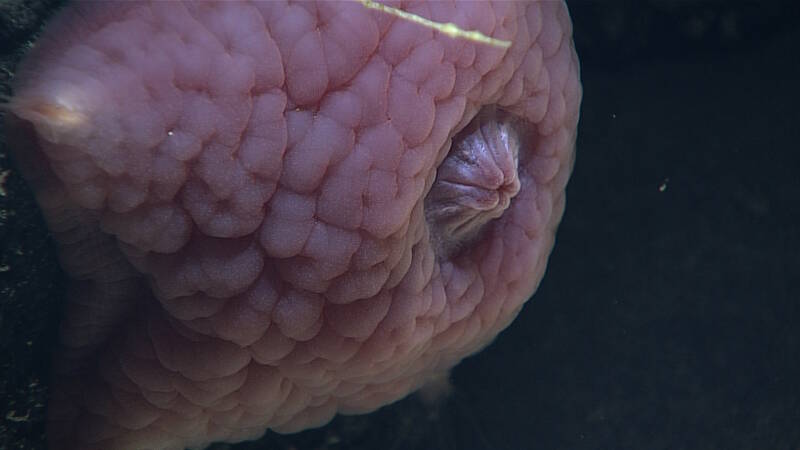
This deep-sea slime star in the genus Hymenaster was imaged during Dive 07 at Titov Seamount. Image courtesy of the NOAA Office of Ocean Exploration and Research, Discovering the Deep: Exploring Remote Pacific Marine Protected Areas. Download larger version (jpg, 779 KB).
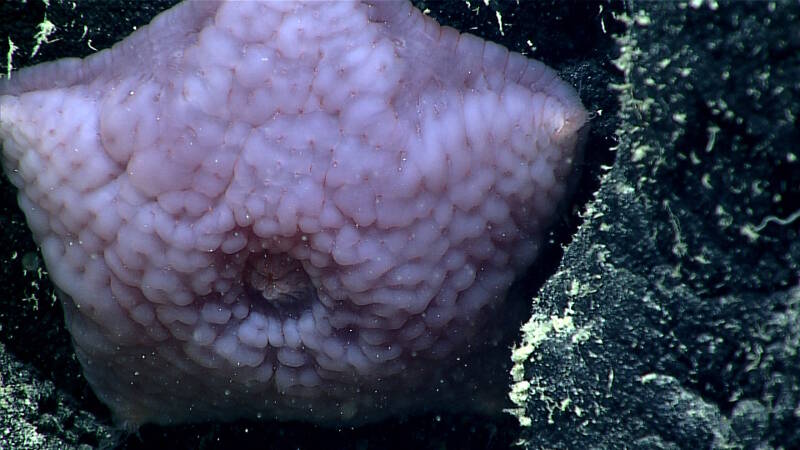
This slime star was imaged during Dive 09 of this expedition. This was the deepest dive around Howland Island. Image courtesy of the NOAA Office of Ocean Exploration and Research, Discovering the Deep: Exploring Remote Pacific Marine Protected Areas. Download larger version (jpg, 1.3 MB).
For more information on slime stars, see:
Sea stars in the order Paxillosida have developed a very specific life mode which combines both camouflage and a means to find food. These sea stars use their pointed tube feet and spines to dig into either mud or sand and swallow the surrounding sediment in order to devour urchins, clams, snails, or other shellfish. These stars lack an eversible stomach and so they must swallow their prey rather than devour it externally. Thus, they dig and dig in order to find food.
But more importantly, these animals dig themselves into the sea bottom, leaving only an inconspicuous star-shaped imprint from above. This keeps them concealed from possible predation. During this expedition, we saw a good-sized purple member of the Paxillosida on an unnamed seamount in the Phoenix Islands Protected Area. Although there was not enough for a positive species identification, it was possibly in the family Astropectinidae.
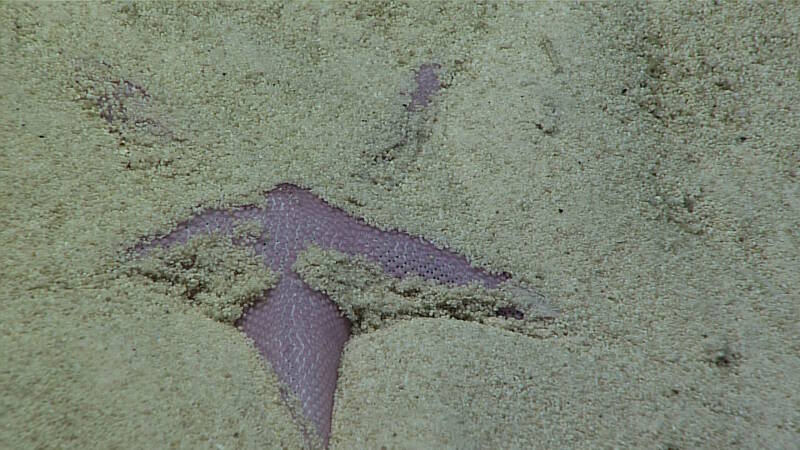
This sea star burrowing itself in the sand was imaged during Dive 04 of the expedition at an unnamed seamount in the Tokelau Seamount Chain. It was too buried for positive identification, but is possibly in the family Astropectinidae. Image courtesy of the NOAA Office of Ocean Exploration and Research, Discovering the Deep: Exploring Remote Pacific Marine Protected Areas. Download larger version (jpg, 1.5 MB).
Additional resources on "sand stars" are available here .
Perhaps the opposite of slime stars are "cookie stars" in the family Goniasteridae. Just to be clear, not all goniasterids are cookie stars, this term usually only applies to those which are pentagonal or nearly so. There are actually about a half dozen genera of goniasterids which fall under this category. We've seen couple of genera in the region, including both Ceramaster and Plinthaster.
Similar sea stars in the fossil record have shown scratch and bite marks caused by fish on the plates, forming the marginal boundary around the edge, and I've found similar markings on "cookie stars" in the tropical Pacific.
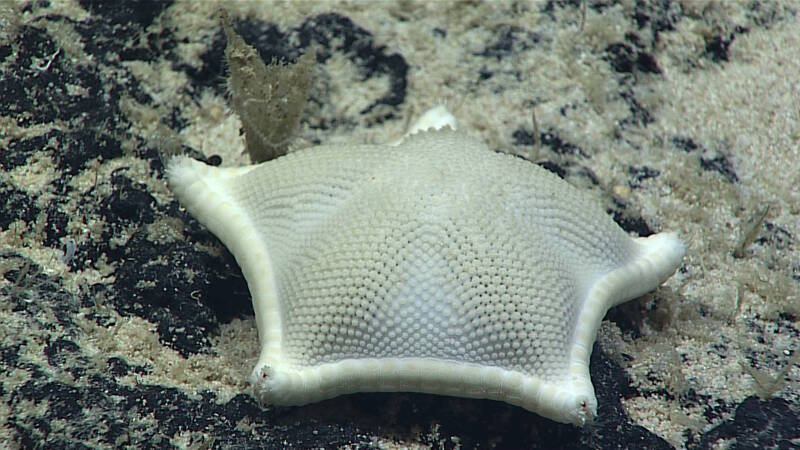
This Ceramaster “cookie star” was imaged during Dive 03 of this expedition at Carondelet Reef. Image courtesy of the NOAA Office of Ocean Exploration and Research, Discovering the Deep: Exploring Remote Pacific Marine Protected Areas. Download larger version (jpg, 1.3 MB).
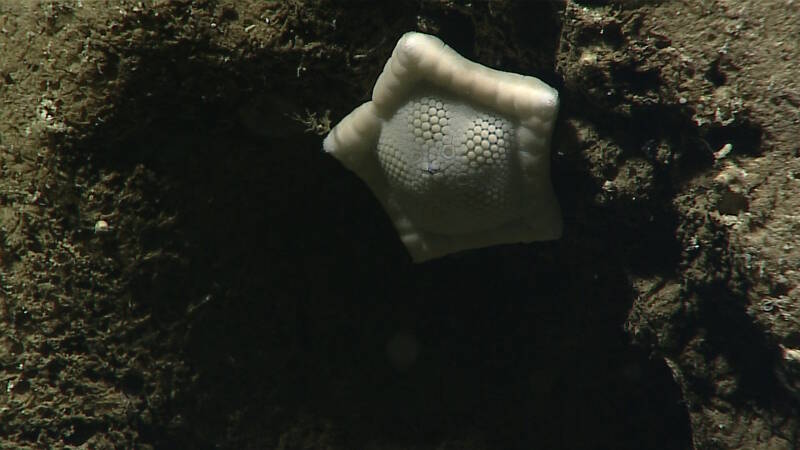
This Plinthaster “cookie” sea star was imaged during Dive 10 of this expedition, at a shallow site within Howland Island. Image courtesy of the NOAA Office of Ocean Exploration and Research, Discovering the Deep: Exploring Remote Pacific Marine Protected Areas. Download larger version (jpg, 942 KB).